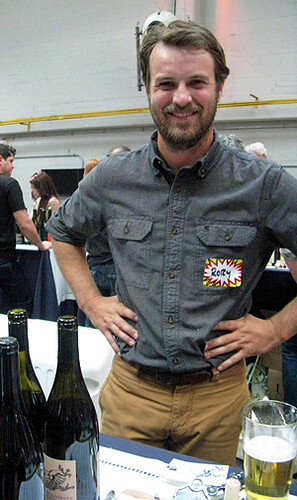Notes from the Fourth Annual Seven % Solution Tasting – May 13th, 2016
I attended the fourth annual Seven % Solution Tasting in mid-May, and wrote a report for the Grape-Nutz.com website. A portion of the report is below – there are more comments, photos, and tasting impressions of over 90 wines from 24 producers here:
Fourth Annual Seven % Solution Tasting – May 13th, 2016
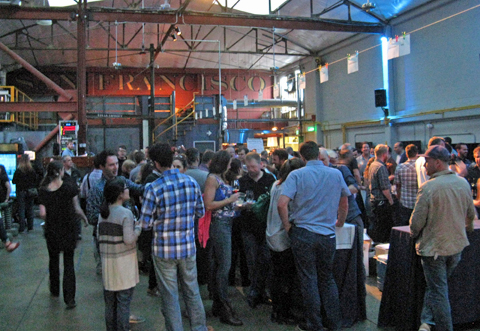
Report on the fourth annual Seven % Solution Tasting, held on Friday May 13th, 2016, at Folsom Street Foundry in San Francisco. The event showcased wines made from California’s less widely-planted grape varieties.
As it has been from the start, the Seven % Solution tasting was presented by Bergamot Alley wine bar in Healdsburg. The Wednesday tasting I attended comprised an afternoon trade / media tasting with a public tasting in the evening – a second public tasting was held at Bergamot Alley on Saturday May 14th. According to the information provided by the event organizers, just eight grape varieties comprise about 93% of winegrape acreage planted in Northern California – the idea of this tasting was to highlight the other 7%, many of them lesser-known varieties.
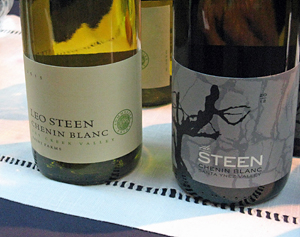
Overall Impressions
This was my third time attending the Seven % Solution tasting. The line-up of wineries that have participated in this event has changed a little since their first event in 2013, but the majority of the group has remained, and with a larger venue than their original one, they’ve been able to add more producers the past couple of years.
As I did last year, I attended the afternoon trade / media tasting and then stayed for the evening tasting to help pour for one of the wineries. Last year I helped out at Edmunds St. John and this year it was at Harrington Wines (where I work part-time) – this was Harrington’s first time at Seven % Solution. To avoid any appearance of conflict of interest, I have not included my tasting impressions of the Harrington wines, only some general notes about them. Staying for the evening tasting did give me the opportunity to get out from behind the winery table for awhile to taste the wines from a few more producers – a nice bonus.
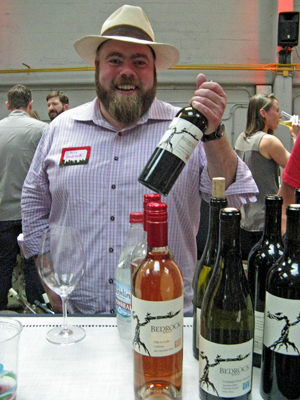
Chris Cottrell, Bedrock
The tasting was set up with the winery tables arranged alphabetically in two lines running down the center of the space, and there was plenty of room to mill around so it never felt overly crowded, despite what looked to be very good attendance at both the afternoon and evening tastings. There was food available from the kitchen at the rear of the space, and an entertaining string band played during the evening session. The event was well-organized and ran very smoothly.
I’ve found that this tasting continues to increase in its breadth. The number of grape varieties presented was impressive – there were about 60 different varieties, either made as single-varietal wines or as part of blends, represented at this year’s event. Although nearly all the participating wineries are located in Napa, Sonoma, and the urban Bay Area, a number of these local producers source fruit from other regions, including vineyards in the Sierra Foothills, Central Coast, Mendocino, and Lodi. There were producers who focused on wines from particular regional varieties – Italian, Iberian, Austrian, Rhône Valley – though most were not as specialized. Thanks to being able to spend extra time trying a few wines during the evening tasting, I managed to sample wines from 25 of the 26 producers pouring at the event.
Rory Williams, Calder
Some of the grape varieties represented at this tasting are truly rare in California, such as Cortese, Loureiro, Petit Manseng, and Roter Veltliner. A few that were nearly as rare only a few years ago, such as Gamay Noir, Ribolla Gialla, and Trousseau, are being planted on a still-small but increasing scale. Other varieties were once fairly common in the state but are no longer seen nearly as much, such as Trousseau Gris (once known as Grey Riesling), Valdiguié (once known as Napa Gamay), and Mission. So trying many of the wines at the Seven % Solution tasting provides a glimpse of California’s wine past and perhaps of its future as well.
The wineries participating in the Seven % Solution tasting share a desire to do something different, and that was clear not only in the choice of grape varieties but in the non-mainstream winemaking techniques that many of them employ. In fact, one could argue that in some cases this tasting showcased those techniques as much as or more than the grape varieties themselves. Skin-fermented whites, whole-cluster fermented reds, carbonic maceration, lengthy extended maceration, use of amphorae and concrete tanks, etc. – all were on display. And while many of the producers at this tasting shied away entirely from newer oak in their wines, a few others demonstrated that a percentage of new oak can work very well with some of these varieties if it is handled appropriately to keep it in balance.
[resizeableimage=300,322]http://www.grape-nutz.com/kenz/images/11-diego-roig,-living-wines-collective.jpg[/resizeableimage]
Diego Roig, Living Wines Collective
With a few exceptions (such as Riesling), the grape varieties highlighted at this tasting are not widely-considered to be “noble” or “classic” varieties. But that’s not to say that there is not a significant place for these “7%” wines. Many of them can be tremendously versatile and food-friendly. Most producers of these lesser-known varieties in California seem to realize this, seeking to make wines that are distinctive and fun, yet of high quality – and for the most part keeping prices reasonable as well.
My list of Favorites for the tasting includes a broad range of varieties, with an even split between reds and whites/rosés, though my “almost favorites” Others of Note list is weighted toward whites. Overall this was the strongest group of wines yet at Seven % Solution. I thought that Bedrock, Calder, Dirty and Rowdy, Edmunds St. John, La Clarine Farm, Living Wines Collective, Matthiasson, Ryme, Tatomer, The Scholium Project, and Wind Gap presented particularly impressive line-ups of wine, with several others not far behind.
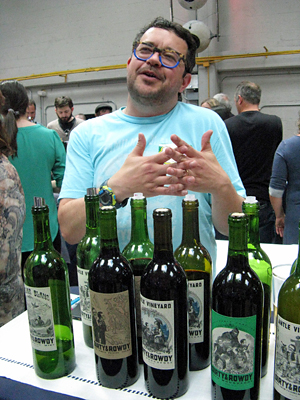
Hardy Wallace, Dirty & Rowdy
Attending the Seven % Solution tasting at Folsom Street Foundry was a pretty good way to spend Friday the 13th! This has become one of my favorite annual Bay Area wine events. With so much diversity in the wines, there’s always something new and different to try so the tasting stays fresh every year. As I’ve noted before, the vintners at this tasting represent only a few of those throughout California who are working with less-common grape varieties – this should act as a springboard for you to go out and discover more of them. If you have an opportunity to attend next year’s Seven % Solution tasting, don’t miss it!
Favorites
Whites, Rosés, and Sparkling
Arnot-Roberts 2014 “Old Vine White Wine”
Bedrock 2015 “Ode to Lulu” Rosé
Calder 2015 Dry Riesling
Donkey and Goat 2015 “Blanca” Pinot Gris
Edmunds St. John 2015 “Heart of Gold”
La Clarine Farm 2014 Petit Manseng
Leo Steen 2012 Jurassic Vineyard Chenin Blanc
Ryme 2013 “Crackling Carignane”
Ryme 2015 “Hers” Vermentino
Ser 2015 Rosé of Nebbiolo
Tatomer 2015 “Meeresboden” Grüner Veltliner
Tatomer 2014 “Vandenberg” Riesling
The Scholium Project 2015 “Blowout”
Two Shepherds 2013 “A Tribute to Saralee Kunde” Grenache Blanc
Reds
Bebame 2014 Red
Bedrock 2014 Evengelho “Heritage”
Dirty and Rowdy 2014 Antle Vineyard Mourvèdre
Dirty and Rowdy 2014 Skinner White Oak Flats Vineyard Mourvèdre
Edmunds St. John 2014 “Bone-Jolly” Gamay Noir
Elizia 2014 Carignane
Ferdinand 2013 Tempranillo
Idlewild 2015 “The Bird”
Jolie-Laide 2015 Gamay
La Clarine Farm 2015 “Jambalaia Rouge”
Matthiasson 2013 Refosco
Nico 2013 “il Cannonau”
RPM 2014 Gamay Noir
Wind Gap 2015 “Soif”
Others of Note
Bedrock 2014 Compagni-Portis “Heritage White”
Calder 2015 Chenin Blanc
Dirty and Rowdy 2015 “Familiar” Mourvèdre
Idlewild 2015 “The Bee”
Idlewild 2013 Nebbiolo
Matthiasson 2013 White Wine
Pax 2015 “Buddha’s Dharma” Chenin Blanc
Populis 2015 “Reversée” Carignane
The Scholium Project 2014 “Steverjan” Pinot Gris
Two Shepherds 2013 “Centime”
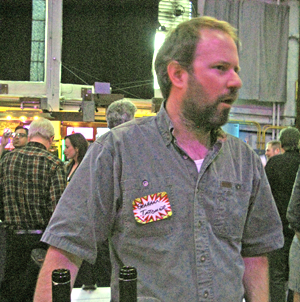
Graham Tatomer
